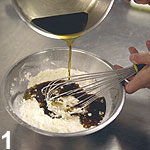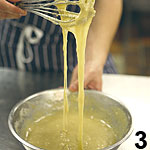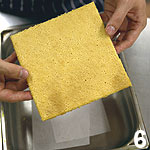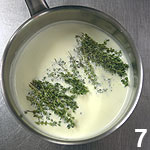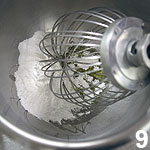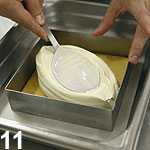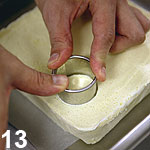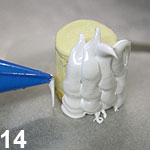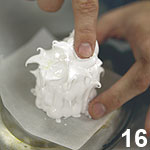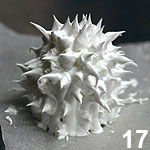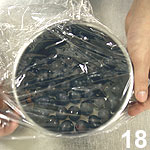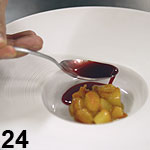Marcus Eaves' Baked Alaska Masterclass
Baked Alaska is back, thanks to a modern reworking by Marcus Eaves, head chef of the Michelin-starred L'Autre Pied in London. Michael Raffael explains just how this latest version of the dessert is created.
It's an icon of the repertoire. Every chef knows what Baked Alaska is but outside of catering college few will have made it. It has slipped off the culinary radar, partly because meringue desserts went out of fashion, partly because the basic recipe wasn't suited to modern service. It was one of those dishes where the waiter entered the dining room with pomp and circumstance and everyone went "Gosh"!
Stripped of the theatre and its concept, it's pretty basic. It got left behind as much by chefs' imagination as by their evolving technical know-how.
Bringing it back in a way that makes it both viable and exciting is no mean achievement but that's just what chef Marcus Eaves has managed. He has studied the components and reworked them. Instead of the sponge base he has substituted an almond biscuit. He has replaced the bland ice-cream core with more subtle shades of flavour.
Meringue and ice-cream balance as an individual portion and, last but not least, he serves the Baked Alaska with a fruit consommé that tones down the sweetness. It's both suave and refreshing.
The hot-and-cold technology isn't rocket science. Egg white is a poor heat conductor. When the ice-cream goes into the oven, it acts as a fire blanket. It's not hard to visualize corner-cutting chefs firing a blow torch at the raw meringue to make it look as though it has been baked. But done this way the whites won't cook and the quality will suffer.
For all the changes, Eaves has created a dish that is in a direct line from its Escoffier roots. Modern? Yes, but not divorced from the past.
MARCUS EAVES
A restaurant reviewer described the cooking of Marcus Eaves's mentor, Shane Osborn, as "beautifully engineered". It's a tag that describes Marcus's own food. Still under 30, he has learnt to harness lessons acquired during stints with Martin Blunos, Claude Bosi, John Burton-Race and Andreas Antona.
His most significant influence though, is his father, Jim Eaves, still the head chef at Oxfordshire hotel Banbury House. That's where he started as a teenage kitchen porter and decided what his career would be.
A year after opening L'Autre Pied, the sister restaurant of Pied à Terre, he won a Michelin star to go with a pocketful of other awards: Square Meal and Time Out's Best New Restaurant 2008 and the Good Food Guide's Upcoming Chef 2008.
The one-time Gordon Ramsay scholar chose to spend the stage that was part of the prize at Mugaritz in the Basque Country. His cuisine may not reflect the tricks of the modern Spanish kitchen, but there's a thoughtfulness to his cooking of which Andoni Aduriz would surely approve.
BAKED ALASKA, DAMSON CONSOMME AND SPICED VICTORIAN PLUMS
INGREDIENTS (Serves one)
- 1 Baked Alaska, fresh out of the oven
- 2-3tbs damson consommé
- 50g spiced plums
- 5 drops lemon oil
EQUIPMENT
Pre-cut squares (15cm x 15cm) of baking parchment. Squares of foil - a little larger - under each sheet. Baking trays. 15cm x 15cm x 5cm metal cake frame.
FINANCIERS
In the pastry section, financiers are small almond biscuits. Here the mixture, when baked, forms the base on which to stand the ice-cream. The batch size makes about eight 15cm x 15cm squares, giving nine bases from each one.
INGREDIENTS
- 90g plain flour
- 90g ground almonds
- 120g icing sugar
- 80g liquid honey
- 220g beurre noisette
220g lightly beaten egg white
METHOD
To make the beurre noisette, melt butter in a pan and heat until it goes nut-brown. Strain through a fine-meshed sieve or muslin.
Beat the flour, almonds, sugar, honey and beurre noisette together until they form a sticky mass (1 and 2). Beat in the egg whites to obtain a spreadable texture (3). For each financier sheet, spread a thin, even layer of the paste over the baking parchment with a palette knife (4). Use the metal frame to keep the edges square (5 and 6).
Preheat a fan-assisted oven to 180°C. Bake the financier sheets for six minutes.
Cool and store the sheets in an airtight container, leaving them on the parchment.
LEMON THYME ICE-CREAM
The flavour of the ice-cream can, of course, be altered. The method here is for a Pacojet, but a freshly churned ice-cream would also work. The quantity here is for about three Pacojet beakers, enough for at least 25 portions, with ice-cream left over that could be re-churned.
INGREDIENTS
- 500ml milk
- 500ml double cream
- 30g very fresh lemon thyme
- 200g egg yolk
- 220g caster sugar
METHOD
Bring the milk and cream to the boil in a stainless steel or enamel pan. Add the lemon thyme (7). Take off the heat. Cover the pan with film and let the milk-cream cool completely. Strain into a bowl or fresh pan and discard the herbs.
Whisk the yolk and sugar until pale. Combine with the milk and cream. Heat gently, stirring all the time, to 84°C to make a crème anglaise (the ice-cream base). Cool (8).
Pour the mixture into the Pacojet beakers and freeze. "Pacotise" (ie, churn) the ice-cream.
SWISS MERINGUE
This is the classic basic meringue recipe
INGREDIENTS (For at least 12 servings)
- 200g egg white
- 400g icing sugar
METHOD
Whisk the egg whites till they start to foam (9). Add the icing sugar and continue whisking till they rise, stiffen and shine. The meringue mix should be stiff enough to form a sharp point on the end of the whisk (10). Allow at least eight minutes whisking in the machine.
FORMING BAKED ALASKAS
Put a 15cm x 15cm x 5cm metal cake frame around the financier sheet. Spoon ice-cream on top to a depth of about 4cm and smooth it over (11). Freeze at -18°C till hard. Time will vary but allow several hours or overnight.
Cut out an ice-cream cylinder on its financier base with a 40mm cutter (12 and 13).
Fill a piping bag with meringue and snip off the end to give a 5-7mm nozzle. Pipe lines of meringue over the top and down the sides of the ice-cream (14), enclosing it completely. It's essential that there be no gaps (15).
To obtain a finish that makes the outside look like a "conker", touch the surface of the meringue with a finger tip and pull outwards. A little point will emerge each time (16).
The cake is ready to bake, but it's better to return it to the freezer one or two hours before service (17).
BAKING
Preheat a fan assisted oven to 250°C. Stand the Baked Alaska on a cold baking sheet.
Bake for 4 minutes until the surface forms a pleasant mid-brown colour.
Once the cake has baked it should be served at once, but the ice-cream under the meringue won't start to melt for a few minutes.
DAMSON CONSOMME
INGREDIENTS (Makes about 400ml)
- 50ml stock syrup
- 2 vanilla pods
- 2 star anise
- 1kg damsons
METHOD
Put the syrup, vanilla and star anise in a pan large enough to take the damsons. Put the damsons on top. Boil. Cover the top of the pan with film (18). Cook until the skins start to split (19). Take off the heat and leave to infuse for 15 minutes (20). Pass the liquid through a fine sieve and muslin (21). Press the pulp gently but don't force it or the consommé will cloud.
SPICED VICTORIA PLUMS
Enough for two servings. Fill a water-bath pouch with 120g sliced Victoria plums (on the firm side) (22), 5g icing sugar, 1 star anise and half a vanilla pod. Cook for 8 to 12 minutes in the water bath at 63°C.
PRESENTATION
Put a 40mm hoop in the middle of a soup plate. Half-fill with spiced plums (23). Remove the hoop. Pour the damson soup around it (24). Finish with drops of lemon oil (25). Stand the Baked Alaska on top of the fruit trivet (26).
VARIATIONS
Marcus Eaves has put several variations of this recipe on his menu to reflect seasonal produce:
- Apricots
- Forced rhubarb and cardamom
- Mulled fruit
- Strawberries
The flavour of the ice-cream changes to balance with the fruit.
A POTTED HISTORY
In 1895, Jean Giroix, head chef of the Hotel de Paris in Monte Carlo, invented the dish we know today as Baked Alaska. He called it omelette à la suèdoise at first and then changed the name to omelette à la norvegienne - it probably sounded "colder". By the turn of the 20th century it had crossed the Atlantic and there changed its name to Baked Alaska.
The mid-19th century French food writer Baron Leon Brisse, claimed that a Chinese delegation visited Paris in 1866. While the diplomats were staying at the Grand Hotel, cooks accompanying them baked a ginger-flavoured frozen dessert in a bun to the amazement of the French kitchen brigade.
Escoffier's omelette norvegienne
Cut out an oval-shaped génoise base two centimetres thick. Mound the ice-cream or fruit ice on top of it to form a pyramid effect. Cover this with a smooth coating of meringue. Pipe fluted meringue decoration on top and bake in a very hot oven.
Photography by Lisa Barber (www.lisabarber.co.uk)



